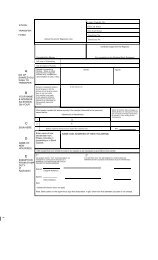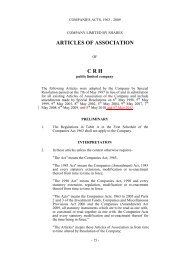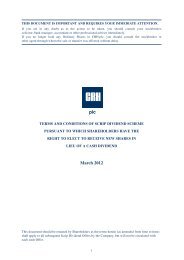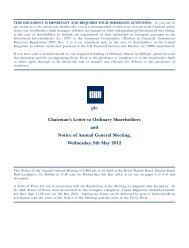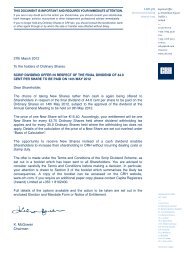2009 Annual Report - CRH
2009 Annual Report - CRH
2009 Annual Report - CRH
- TAGS
- annual
- www.crh.com
You also want an ePaper? Increase the reach of your titles
YUMPU automatically turns print PDFs into web optimized ePapers that Google loves.
21. Capital and Financial Risk Management continued<br />
Foreign currency risk<br />
Due to the nature of building materials, which in general exhibit a low value-to-weight ratio, <strong>CRH</strong>’s activities are conducted primarily in the local currency of the country<br />
of operation resulting in low levels of foreign currency transaction risk; variances arising in this regard are reflected in operating costs or cost of sales in the Consolidated<br />
Income Statement in the period in which they arise and are shown in note 4.<br />
Given the Group’s presence in 35 countries worldwide, the principal foreign exchange risk arises from fluctuations in the euro value of the Group’s net investment in<br />
a wide basket of currencies other than the euro; such changes are reported separately within the Consolidated Statement of Comprehensive Income. A currency<br />
profile of the Group’s net debt and net worth is presented in note 25. The Group’s established policy is to spread its net worth across the currencies of its various<br />
operations with the objective of limiting its exposure to individual currencies and thus promoting consistency with the geographical balance of its operations. In order<br />
to achieve this objective, the Group manages its borrowings, where practicable and cost effective, partially to hedge its foreign currency assets. Hedging is done using<br />
currency borrowings in the same currency as the assets being hedged or through the use of other hedging methods such as currency swaps.<br />
The following table demonstrates the sensitivity of profit before tax and equity to selected movements in the relevant €/US$ exchange rate (with all other variables held<br />
constant); the US Dollar has been selected as the appropriate currency for this analysis given the materiality of the Group’s activities in the United States:<br />
Percentage change in relevant €/US$ exchange rate +/- 5% +/-2.5%<br />
Impact on profit before tax <strong>2009</strong> -/+ €14m -/+ €7m<br />
2008 -/+ €29m -/+ €15m<br />
Impact on equity * <strong>2009</strong> -/+ €170m -/+ €87m<br />
2008 -/+ €160m -/+ €82m<br />
* Includes the impact on financial instruments which is as follows: <strong>2009</strong> +/- €105m +/- €54m<br />
2008 +/- €139m +/- €71m<br />
Financial instruments include deposits, money market funds, bank loans, medium term notes and other fixed term debt, interest rate swaps, commodity swaps and<br />
foreign exchange contracts. It excludes trade receivables and trade payables.<br />
Credit risk<br />
In addition to cash at bank and in hand, the Group holds significant cash balances which are invested on a short-term basis and are classified as either cash<br />
equivalents or liquid investments (see note 22). These deposits and other financial instruments (principally certain derivatives and loans and receivables included within<br />
financial assets) give rise to credit risk on amounts due from counterparties. Credit risk is managed by limiting the aggregate amount and duration of exposure to any<br />
one counterparty primarily depending on its credit rating and by regular review of these ratings. Acceptable credit ratings are high investment grade ratings - generally<br />
counterparties have ratings of A2/A or higher from Moody’s/Standard & Poor’s ratings agencies. The maximum exposure arising in the event of default on the part of<br />
the counterparty is the carrying value of the relevant financial instrument.<br />
Credit risk arising in the context of the Group’s operations is not significant with the total bad debt provision at the balance sheet date amounting to circa 8.1% of<br />
gross trade receivables (2008: 6.3%). Customer credit risk is managed at appropriate Group locations subject to established policies, procedures and controls.<br />
Customer credit quality is assessed in line with strict credit rating criteria and credit limits established where appropriate. Outstanding customer balances are regularly<br />
monitored and a review for indicators of impairment (evidence of financial difficulty of the customer, payment default, breach of contract etc.) is carried out at each<br />
reporting date. Significant balances are reviewed individually while smaller balances are grouped and assessed collectively. Receivables balances are in general<br />
unsecured and non-interest-bearing. The trade receivables balances disclosed in note 18 comprise a large number of customers spread across the Group’s activities<br />
and geographies with balances classified as neither past due nor impaired representing 78% of the total receivables balance at the balance sheet date (2008: 84%);<br />
amounts receivable from related parties (notes 18 and 33) are immaterial. Factoring and credit guarantee arrangements are employed in certain of the Group’s<br />
operations where deemed relevant by operational management.<br />
Liquidity risk<br />
The principal liquidity risks faced by the Group stem from the maturation of debt obligations and derivative transactions. The Group’s corporate treasury function<br />
ensures that sufficient resources are available to meet such liabilities as they fall due through a combination of liquid investments, cash and cash equivalents, cash<br />
flows and undrawn committed bank facilities. Flexibility in funding sources is achieved through a variety of means including (i) maintaining cash and cash equivalents<br />
and liquid resources only with a diversity of highly-rated counterparties; (ii) limiting the maturity of such balances; (iii) borrowing the bulk of the Group’s debt requirements<br />
under committed bank lines or other term financing; and (iv) having surplus committed lines of credit.<br />
The undrawn committed facilities available to the Group as at the balance sheet date are quantified in note 23; these facilities span a wide number of highly-rated<br />
financial institutions thus minimising any potential exposure arising from concentrations in borrowing sources. The repayment schedule (analysed by maturity date)<br />
applicable to the Group’s outstanding interest-bearing loans and borrowings as at the balance sheet date is also presented in note 23.<br />
92 <strong>CRH</strong>








